The NBJ's 2010 Recoding Session |
You may not believe this, but the Night Blooming Jazzmen don’t rehearse very often. Most of the time, we just “wing it” with little or no thought as to how the tunes will unfold in front of our audiences. After all, this is a big part of jazz. We make an exception when we are planning to record a CD. Studio time is expensive and we want to know what we are doing (or close to it) before we enter the studio. In fact, the NBJ is remarkably efficient in using studio time – more so than any other band I have played with. We typically record an entire CD in only about six hours! Our “Volume 25” was done in about this amount of time.
We recorded “25” at Bryan Shaw’s Digital Brothers Studio – which he built as an addition to his home in south Orange County. If his name is familiar to you, it is probably because he is also the trumpeter with the High Sierra Jazz Band. He is both a fine musician and a fine engineer – and he knows how a band like ours is supposed to sound. |
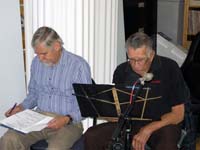 |
We did the entire recording on Saturday, June 25. We had to because I had to jump on an airplane early Sunday. We arrived at the studio at 8:00 AM (which means Jim and I had to leave our homes well before 7:00). We started by setting up all of our instruments. Here you can see Chet discussing the various tunes with Bryan. We had a “roadmap” for each tune that Bryan could use to see which instruments we were using (e.g. banjo or guitar) and the order of the solos. |
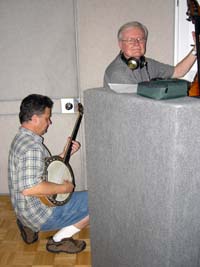 |
Brad did not divulge the name of his banjo feature tune until the session. Here you can see him explaining his chart for “Shakin’ the Blues Away” with Don. We used the setup time to talk this through so as not to waste recording time later. We also ran through the tune a few times at this point. |
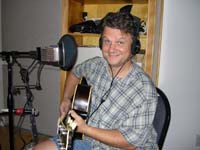 |
Bryan set up each of our microphones. Brad is testing his in this photo. We had one microphone for the banjo and two for the guitar – one at the amplifier and the other near the strings. I had three microphones too – two for the piano and one for my vocals, piccolo solos, and sopranino sax solos. |
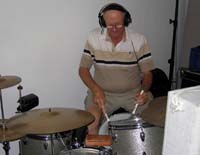 |
Larry got the most microphones of course. After all, he’s the loudest! Notice that Larry is also partially isolated from the rest of us by waist-high dividers. Although you might think this is to protect the other musicians from flying sticks and drum paraphernalia, it is actually to limit the amount of drum sound that is picked up by our other microphones. |
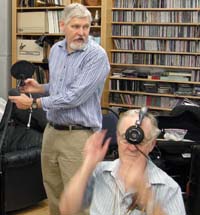 |
We all wear headphones during the recording so we can hear each other and ourselves. It’s really not very complicated, though Bryan had to demonstrate the technique to Jim a few times before he understood. We recorded each of the tunes at least twice so that there was a higher chance that Bryan could glean good notes from each of us! We did some of the tougher arrangements three or four times. |
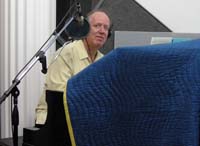 |
Here I am at a very nice piano. Bryan’s studio has a Steinway with adjustable touch. It had been tuned just before we arrived that morning. The tuner was none other than Mike Olson, the leader of the Burgundy Street Band who left just as I arrived! |
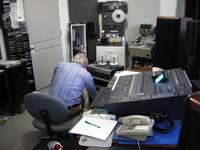 |
Here you see the nerve center of the studio – the “booth.” Its not the best photo of Bryan, however! He has a completely digital studio. In the post-recording mixing he will work lots of magic to make the band sound much more polished than it is in real life! As Chet always says, “Our recordings sound better than we do.” Bryan's booth is located on the second story of the building and it looks down on the studio floor. Bryan spent a great deal of time running up and down the stairs - probably making more than a hundred trips during the day. No wonder he stays so thin! |
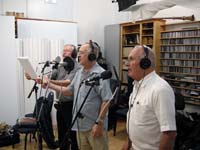 |
The last task of the session was the overdubbing of group vocals. Here Dick, Jim, and Don are laying down vocal tracks for “Floating Down to Cotton Town” using tight three-part harmony that I wrote for them a few weeks back. |
|
There is a bit more, of course. Bryan will spend many hours creating the final mixes of each tune and will then create the "master" of the CD. In parallel, Chet will do the design of the labeling and liner notes. He will send this and the CDs out for duplication, printing, and packaging.
Now that you know more about how our recordings are made, we hope you will enjoy them even more - and of course we hope you will buy them! |
| |
|